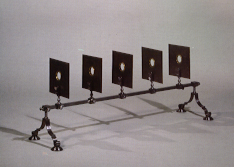
23 x 132 x 21.5
Iron and brass
INDEX 1788 : V.II.III.320
Scala Optica, quae componitur ex virga ferrea quatuor pedes longa, in partes aliquod aequales divisa, et firmis fulcris ferreis insistente. Huic imponuntur seorsim laminae ferreae quadratae quinque pedamentis praeditae, quae hinc inde super virgam demoveri, et cochleis firmari possunt ut consistant. Quaelibet lamina in medio perforata est, et circellum habet ex orichalco cui aptari possunt lentes qualiscumque figurae, ac determinatae magnitudinis. Ad eandem pariter Machinam pertinet Tabella rotunda, charta obducta, aequali pedunculo ferreo munita, ut in extremo capite virgae consistere posit, et in hac imagines candelae ardentis per lentes projectas, velut in camera obscura excipiuntur. Hac Machina utimur ad ostendendas qualescumque lentium affectiones.
Optical bench composed of an iron rod four feet in length divided in some equal parts and supported on firm iron supports. To it five square iron blades are applied, separately adjusted with stakes, that on one or the other side are moved along the rod and can be fixed with screws to remain immovable. All of the blades are perforated in the middle and have a small brass hoop to which lenses of any format but with limited thickness may be adapted. A round board also belongs to this same machine, covered with a leaf and equipped with a similar iron stand to be able to end at one extremity of a rod and on it the images of the lit candle are projected by the lenses as if they were received in a dark chamber. This machine is used to show all of the properties of lenses.
This device consists of an optical bench, composed of an iron bar with a rectangular section, mounted on two supports and along which iron squares with brass frames are mounted, having an orifice 5 cm in diameter in the centre. The iron squares measure 22 cm on each side and in the central orifice there is a brass ring with an interior screw which allows for the removal of a second ring, for the installation of various lenses (which no longer exist) used in experimental work. The iron bar is 1.2 m in length and is equipped with a scale graduated in centimetres. With this scale, it is possible to define the positions of the object and of the image given by the lens. To perform the experiments, the lens case is installed on the graduated ruler, with a parallelipipedic support, in which there is an opening allowing it to move along the bar. It is fixed by a screw located on one of the lateral faces of the parallelepiped. This device is not complete, the screen where the images were projected no longer exists.
From Colégio dos Nobres, catalogue n.º 310.
Sigaud de la Fond, Joseph-Aignan, Description et Usage d'un Cabinet de Physique Expérimental, Paris, 1775, Tomo II, P1. XVII,
Figs. 10, 11, 12.